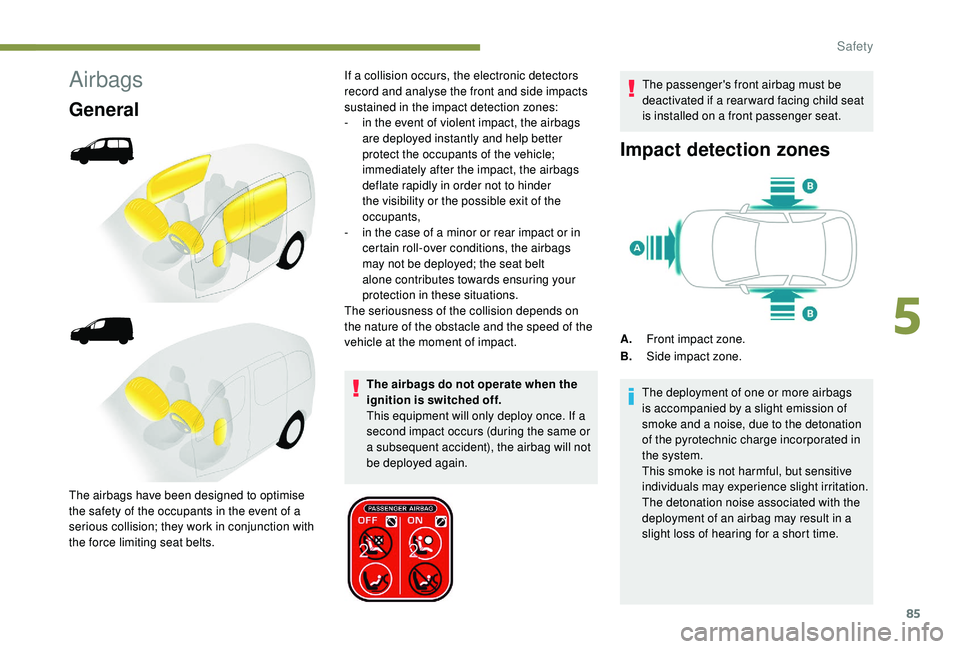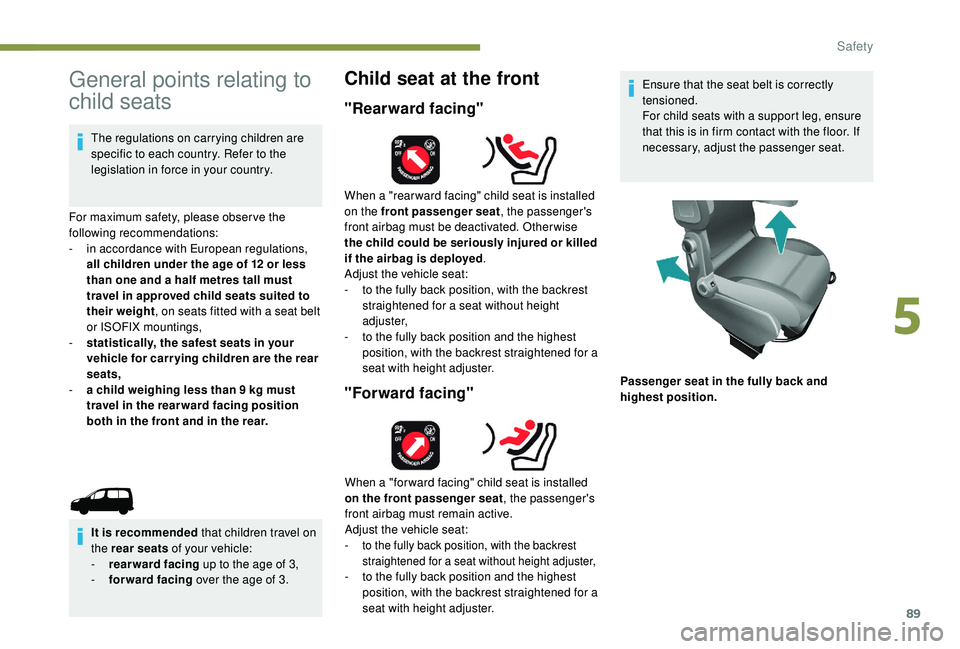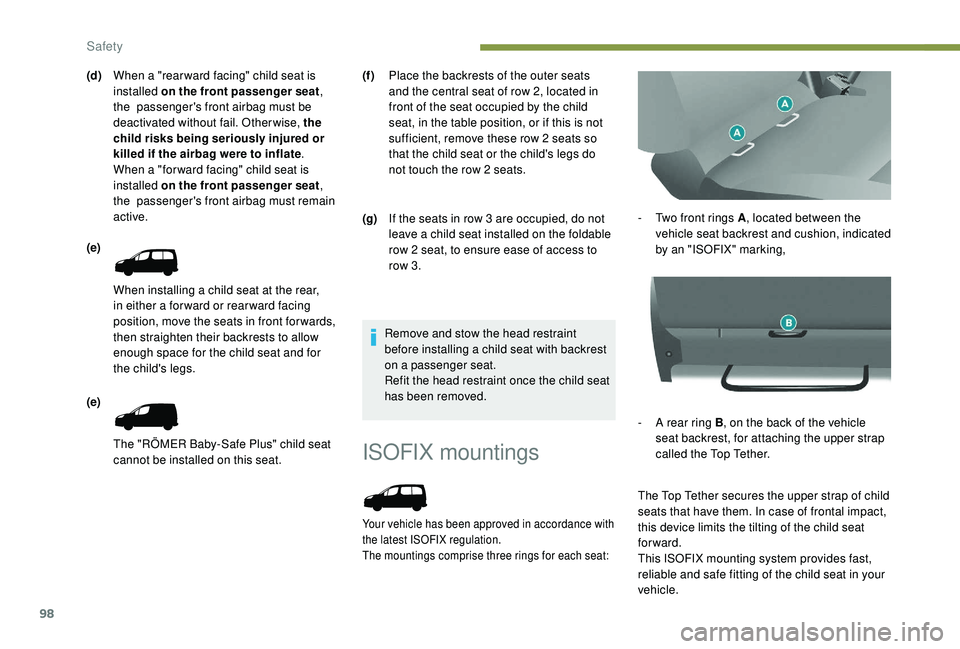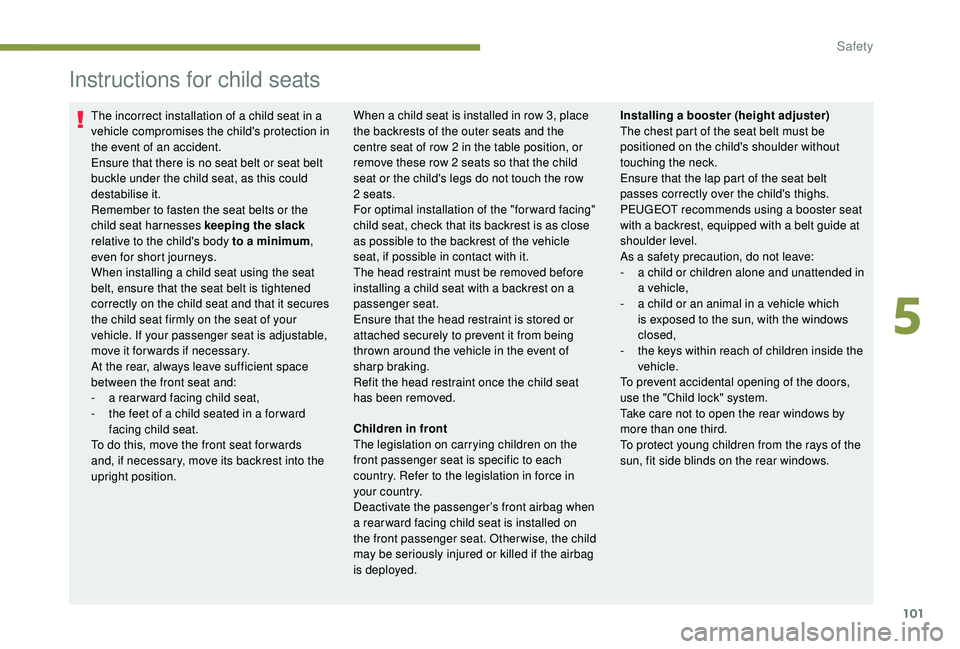2020 PEUGEOT PARTNER TEPEE deactivate passenger airbag
[x] Cancel search: deactivate passenger airbagPage 87 of 216

85
Airbags
General
The airbags do not operate when the
ignition is switched off.
This equipment will only deploy once. If a
second impact occurs (during the same or
a subsequent accident), the airbag will not
be deployed again.The passenger's front airbag must be
deactivated if a rear ward facing child seat
is installed on a front passenger seat.
Impact detection zones
A.
Front impact zone.
B. Side impact zone.
The deployment of one or more airbags
is accompanied by a slight emission of
smoke and a noise, due to the detonation
of the pyrotechnic charge incorporated in
the system.
This smoke is not harmful, but sensitive
individuals may experience slight irritation.
The detonation noise associated with the
deployment of an airbag may result in a
slight loss of hearing for a short time.
If a collision occurs, the electronic detectors
record and analyse the front and side impacts
sustained in the impact detection zones:
-
i
n the event of violent impact, the airbags
are deployed instantly and help better
protect the occupants of the vehicle;
immediately after the impact, the airbags
deflate rapidly in order not to hinder
the visibility or the possible exit of the
occupants,
-
i
n the case of a minor or rear impact or in
certain roll-over conditions, the airbags
may not be deployed; the seat belt
alone contributes towards ensuring your
protection in these situations.
The seriousness of the collision depends on
the nature of the obstacle and the speed of the
vehicle at the moment of impact.
The airbags have been designed to optimise
the safety of the occupants in the event of a
serious collision; they work in conjunction with
the force limiting seat belts.
5
Safety
Page 88 of 216

86
Front airbags
Activation
The airbags are deployed (except the
passenger's front airbag if it is deactivated)
in the event of a serious frontal impact to all
or part of the frontal impact zone A, in the
longitudinal centreline of the vehicle on a
horizontal plane and directed from the front to
the rear of the vehicle.
The front airbag inflates between the front
occupant of the vehicle and the dashboard, to
cushion their forward movement.
Operating fault
If this warning lamp comes on,
accompanied by an audible warning
and a message on the screen,
contact a PEUGEOT dealer or a
qualified workshop to have the
system checked.
If the two airbag warning lamps remain
on continuously, do not install a "rear ward
facing" child seat, contact a PEUGEOT
dealer or a qualified workshop.
Lateral airbags
This system protects the driver and front
passenger in the event of a severe side impact
in order to limit the risk of injury to the thorax.
These are incorporated in the centre of
the steering wheel for the driver and in the
dashboard for the front passenger(s).
Each lateral airbag is fitted in the front seat's
backrest frame, door side.
Activation
The lateral airbag is deployed on one side in
the event of a severe side impact covering all
or part of side impact zone B, perpendicular to
the longitudinal centreline of the vehicle in a
horizontal plane and directed from the outside
towards the inside of the vehicle.
The lateral airbag inflates between the front
occupant and the corresponding door panel.
Operating fault
If this warning lamp comes on in the
instrument panel, accompanied by an
audible warning and a message on the
screen, contact a PEUGEOT dealer or
a qualified workshop to have the system
checked. The airbags may no longer be
deployed in the event of a serious impact.
In the event of a minor impact or bump on
the side of the vehicle or if the vehicle rolls
over, the airbags may not be deployed.
Safety
Page 91 of 216

89
General points relating to
child seats
The regulations on carrying children are
specific to each country. Refer to the
legislation in force in your country.
For maximum safety, please obser ve the
following recommendations:
-
i
n accordance with European regulations,
all children under the age of 12 or less
than one and a half metres tall must
travel in approved child seats suited to
their weight , on seats fitted with a seat belt
or ISOFIX mountings,
-
s
tatistically, the safest seats in your
vehicle for carr ying children are the rear
seats,
-
a c
hild weighing less than 9 kg must
travel in the rear ward facing position
both in the front and in the rear.
Child seat at the front
"Rearward facing"
"Forward facing"
Ensure that the seat belt is correctly
tensioned.
For child seats with a support leg, ensure
that this is in firm contact with the floor. If
necessary, adjust the passenger seat.
Passenger seat in the fully back and
highest position.
It is recommended that children travel on
the rear seats of your vehicle:
-
re
arward facing up to the age of 3,
-
fo
rward facing over the age of 3. When a "rear ward facing" child seat is installed
on the front passenger seat
, the passenger's
front airbag must be deactivated. Other wise
the child could be seriously injured or killed
if the airbag is deployed .
Adjust the vehicle seat:
-
t
o the fully back position, with the backrest
straightened for a seat without height
adjuster,
-
t
o the fully back position and the highest
position, with the backrest straightened for a
seat with height adjuster.
When a "for ward facing" child seat is installed
on the front passenger seat , the passenger's
front airbag must remain active.
Adjust the vehicle seat:
- to the fully back position, with the backrest straightened for a seat without height adjuster,
- to the fully back position and the highest position, with the backrest straightened for a
seat with height adjuster.
5
Safety
Page 93 of 216

91
In line with current legislation, you will find this
warning in all the required languages in the
following tables.
Deactivating the
passenger's front airbag
Only the passenger's front airbag can be
deactivated.
F
W
ith the ignition off , insert the key into the
passenger airbag deactivation switch.
F
T
urn it to the " OFF" position.
F
R
emove the key while keeping the switch in
this position.
The passenger's front airbag
warning lamp in the dashboard
stays on throughout the deactivation
period. To ensure your child's safety, it is
essential to deactivate the passenger's
front airbag when you install a rear ward
facing child seat on the front passenger
seat. Otherwise, there is a risk of serious
or fatal injury to the child if the airbag is
deployed.
Reactivating the
passenger's front airbag
In the "
OFF" position, the passenger’s front
airbag will not be deployed in the event of an
impact.
As soon as you remove the child seat, turn
the passenger’s front airbag switch to the ON
position to reactivate the airbag and therefore
ensure the safety of your passenger in the
event of an impact.
5
Safety
Page 100 of 216

98
ISOFIX mountings
Your vehicle has been approved in accordance with
the latest ISOFIX regulation.
The mountings comprise three rings for each seat:
- Two front rings A, located between the
vehicle seat backrest and cushion, indicated
by an "ISOFIX" marking,
-
A r
ear ring B , on the back of the vehicle
seat backrest, for attaching the upper strap
called the Top Tether.
The Top Tether secures the upper strap of child
seats that have them. In case of frontal impact,
this device limits the tilting of the child seat
forward.
This ISOFIX mounting system provides fast,
reliable and safe fitting of the child seat in your
vehicle.
Remove and stow the head restraint
before installing a child seat with backrest
on a passenger seat.
Refit the head restraint once the child seat
has been removed.
(d)
When a "rear ward facing" child seat is
installed on the front passenger seat ,
the passenger's front airbag must be
deactivated without fail. Otherwise, the
child risks being seriously injured or
killed if the airbag were to inflate .
When a "for ward facing" child seat is
installed on the front passenger seat ,
the passenger's front airbag must remain
active.
(e)
When installing a child seat at the rear,
in either a for ward or rear ward facing
position, move the seats in front for wards,
then straighten their backrests to allow
enough space for the child seat and for
the child's legs.
(e)
The "RÖMER Baby-Safe Plus" child seat
cannot be installed on this seat. (f )
Place the backrests of the outer seats
and the central seat of row 2, located in
front of the seat occupied by the child
seat, in the table position, or if this is not
sufficient, remove these row 2 seats so
that the child seat or the child's legs do
not touch the row 2 seats.
(g) If the seats in row 3 are occupied, do not
leave a child seat installed on the foldable
row 2 seat, to ensure ease of access to
row 3.
Safety
Page 103 of 216

101
Instructions for child seats
The incorrect installation of a child seat in a
vehicle compromises the child's protection in
the event of an accident.
Ensure that there is no seat belt or seat belt
buckle under the child seat, as this could
destabilise it.
Remember to fasten the seat belts or the
child seat harnesses keeping the slack
relative to the child's body to a minimum,
even for short journeys.
When installing a child seat using the seat
belt, ensure that the seat belt is tightened
correctly on the child seat and that it secures
the child seat firmly on the seat of your
vehicle. If your passenger seat is adjustable,
move it for wards if necessary.
At the rear, always leave sufficient space
between the front seat and:
-
a r
ear ward facing child seat,
-
t
he feet of a child seated in a for ward
facing child seat.
To do this, move the front seat for wards
and, if necessary, move its backrest into the
upright position. When a child seat is installed in row 3, place
the backrests of the outer seats and the
centre seat of row 2 in the table position, or
remove these row 2 seats so that the child
seat or the child's legs do not touch the row
2 seats.
For optimal installation of the "forward facing"
child seat, check that its backrest is as close
as possible to the backrest of the vehicle
seat, if possible in contact with it.
The head restraint must be removed before
installing a child seat with a backrest on a
passenger seat.
Ensure that the head restraint is stored or
attached securely to prevent it from being
thrown around the vehicle in the event of
sharp braking.
Refit the head restraint once the child seat
has been removed.
Installing a booster (height adjuster)
The chest part of the seat belt must be
positioned on the child's shoulder without
touching the neck.
Ensure that the lap part of the seat belt
passes correctly over the child's thighs.
PEUGEOT recommends using a booster seat
with a backrest, equipped with a belt guide at
shoulder level.
As a safety precaution, do not leave:
-
a c
hild or children alone and unattended in
a vehicle,
-
a c
hild or an animal in a vehicle which
is exposed to the sun, with the windows
closed,
-
t
he keys within reach of children inside the
vehicle.
To prevent accidental opening of the doors,
use the "Child lock" system.
Take care not to open the rear windows by
more than one third.
To protect young children from the rays of the
sun, fit side blinds on the rear windows.
Children in front
The legislation on carrying children on the
front passenger seat is specific to each
country. Refer to the legislation in force in
your country.
Deactivate the passenger’s front airbag when
a rear ward facing child seat is installed on
the front passenger seat. Otherwise, the child
may be seriously injured or killed if the airbag
is deployed.
5
Safety